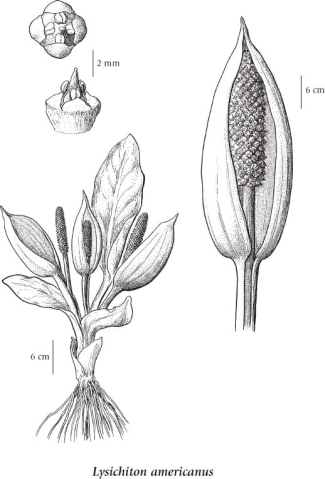Skunk cabbage, or swamp lantern, is a native perennial western North American species found only in a handful of western US states (Washington, Oregon, California, Montana, Idaho) and one Canadian province (British Columbia) (
USDA 2011). A single report from Wyoming may be erroneous (
Flora North America 2011). In British Columbia, it is common in southern BC, west of the Coast-Cascade Mountains, but is less frequent elsewhere in BC, south of 56 degree north (
Douglas et al. 1998). This is an aquatic to semi-aquatic species that is sun and shade tolerant. It is found in swamps, bog edges (lags), wet ditches, sloughs and moist forests in the lowland and montane zones. It is a common species in sloughs along the Fraser River (e.g. Finn Slough).
Skunk cabbages have distinctive large bright yellow 'flowers' or spathes which are actually bracts that surround the spadix (spike) of tiny yellowish-green flowers. Flowering is from early spring (March) through to late spring (May). As the flowers die back, large basal 'cabbage' leaves (up to 150 cm long) appear. Skunk cabbages plants have a distinctive, skunk-like smell that is noticeable when leaves are brushed against, crushed or stepped on.
The large, bright yellow, striking 'flowers' of this species, followed by lush green foliage, have made it an attractive species for gardeners. It was introduced in Europe by gardeners for use in ponds and wet sites, and has escaped and become invasive in some areas. It was first introduced in Great Britain in 1901 and first reported naturalizing in 1947 (Klingenstein and Alberternst 2010). Skunk cabbage plants are reported to live up to 80 years (Klingenstein and Alberternst 2010).
View a photo of this species invading a creek in Glasgow, Scotland.
Flora North America provides a detailed description of this species and discussion of its range.
Read about skunk cabbage in Europe.
